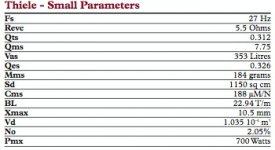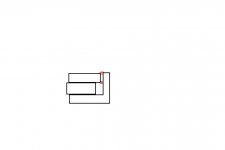DIY 18" PA subwoofer cabinet
Hi All,
I'm new to this forum but not new to sound, music and PA systems. I'm thinking of building a pair of DIY single 18" subwoofer cabinets to go with my pair of Samson DB500a speakers.
I will be using Precision Devices 186 (700w @ 8 Ohm) speaker components, 3/4" birch plywood for construction, and a Behringer EP2500 poweramp in bridged mono (2400w @ 4 Ohms) to power both speakers in parallel. I going for the vented design, would like each sub to go down to around the 30Hz mark and provide loud clear bass for both recorded CD music and a live rock band in a small venue.
I've attached a screenshot of the T/S parameters of the PD.186.
The problem I have is that i'm not really sure how big the cabinets need to be to get the most out of the speaker drivers. I've been using software like WinISD, Boxnotes and AJDesign to try and get a better understanding but i'm still quite baffled on the whole dimensions and the vent side I need. My woodworking skills are up for the task but i'm currently stuck in the design stage.
So any help you guys care to contribute to get me on my way would be most appreciated. Thanks
Hi All,
I'm new to this forum but not new to sound, music and PA systems. I'm thinking of building a pair of DIY single 18" subwoofer cabinets to go with my pair of Samson DB500a speakers.
I will be using Precision Devices 186 (700w @ 8 Ohm) speaker components, 3/4" birch plywood for construction, and a Behringer EP2500 poweramp in bridged mono (2400w @ 4 Ohms) to power both speakers in parallel. I going for the vented design, would like each sub to go down to around the 30Hz mark and provide loud clear bass for both recorded CD music and a live rock band in a small venue.
I've attached a screenshot of the T/S parameters of the PD.186.
The problem I have is that i'm not really sure how big the cabinets need to be to get the most out of the speaker drivers. I've been using software like WinISD, Boxnotes and AJDesign to try and get a better understanding but i'm still quite baffled on the whole dimensions and the vent side I need. My woodworking skills are up for the task but i'm currently stuck in the design stage.
So any help you guys care to contribute to get me on my way would be most appreciated. Thanks
Attachments
PD186 seems like the choice fore you goal 
Fore 30hz you need 250-280 liter(netto), four ports of each ø100mm, 150-200mm long
Total port area of four ø100mm ports are 320cm2, if you want to build slot ports, but its length cant be changed, which is possible with the round port tubes
Could be that with longer ports a smaller box may be possible, but cant help you with that
Anyway, shorter ports mostly seem to work/sound better
Fore 30hz you need 250-280 liter(netto), four ports of each ø100mm, 150-200mm long
Total port area of four ø100mm ports are 320cm2, if you want to build slot ports, but its length cant be changed, which is possible with the round port tubes
Could be that with longer ports a smaller box may be possible, but cant help you with that
Anyway, shorter ports mostly seem to work/sound better
Thanks for the reply. You know what, i've been trying to calculate port sizes all day and was finding it difficult to design a cabinet around two ports with really long lengths each. I never thought of adding more ports to my design and thus reducing the required port length. I think with your help i may be on to something now. Thanks
KOA said:when adding more ports for a given box size and port diameter, the length of the ports will increase if I am not mistaken.
So it is
This driver seem to like a very big port...and I mostly try to keep port length within 100-250mm
I have split it up in 4...but it could also be 3, if thats more convenient
I made it 4, so that each would be ø100mm
The area of one ø100mm is 80cm2, which means the total area of 4 ports calculated is 320cm2...which gives an ok port length
But the calculated port is not always the optimal...fore that you have to experiment a bit, either with measurements or listening
You're right about more ports relating to more port length needed. Found that out after reading the reply and punching numbers into WinISD.
It suggests that I use a box with a volume of 152.61 litres and tuned to 27Hz. If I have two 10.20cm circular ports with a cross area of 163.4cm^2, the vent length would have to be 37.66cm.
If I wanted to use rectangular ports like you see on subwoofer models like the Peavey UL118S, how would I go about calculating the length needed?
Thanks
It suggests that I use a box with a volume of 152.61 litres and tuned to 27Hz. If I have two 10.20cm circular ports with a cross area of 163.4cm^2, the vent length would have to be 37.66cm.
If I wanted to use rectangular ports like you see on subwoofer models like the Peavey UL118S, how would I go about calculating the length needed?
Thanks
CruiSE said:
If I wanted to use rectangular ports like you see on subwoofer models like the Peavey UL118S, how would I go about calculating the length needed?
Thanks
Its the same...width x height = area
Only, you use the width of box
But I would split it up in 3 or 4 sections
Makes the calculation slightly more tricky
Personally I would stay away from very long ports
I think the port length should relate to individual ports area...so ofcourse big ports may be longer, but not too much
Another possible option could be triangular ports in the corners
4 riangular ports calculates as 2 squared ports
165 liter is only half of VAS, and sound a bit smallish to me...you have to look out fore overshoot/peak(boxQ)
...I dont think you want that with such big woofer
You will also have some room gain, and normally a smooth gradual rolloff is preferred
About 160 - 200 liter would be common for PA-purposes. I suggest you build the G-sub from speakerplans as it was designed for that particular speaker (the 10.5 mm Xmax is a bit overstated) http://speakerplans.com/index.php?id=gsub
Best regards Johan
Best regards Johan
Rademakers said:(the 10.5 mm Xmax is a bit overstated) Best regards Johan
Magnet gap is 9mm, and voicecoil is 25mm, which leaves you with roughly +/- 8mm(16mm p-p)
Its still quite good
To me it seems like strange things has been happening at PrecisionDevices during the last year or so
Some of their new drivers with neo magnet has been discontinued and archived, along with some other woofers with highish Qts
I reckon that they have realised that woofers with such highish Qts is not really durable fore hard PA...with nice low Fs they simply go too deep fore their own good
Its a real pitty, as excactly those woofers are the ones we could use fore hifi

Rademakers said:
I always believed it had more to do with the marketing department than science.
Best regards Johan
I think not with a company like Precision Devices
To the best of my knowledge, the magnet field around the edges will behave something like this
A behaviour that may be improved further by clever design
Its my own drawing
Attachments
Man, I just realised I may be completely wrong on this Xmax issue
If my above drawing is fore real, it could actually seem like the opposite happens
The "pseudo" widening of the magnetgap, due to field bending out at the edges, it may be considered like a bit thicker poleplate
It could mean greater field force, but in reality it could actually also lead to even less linear Xmax, like if the poleplate was thicker

If my above drawing is fore real, it could actually seem like the opposite happens
The "pseudo" widening of the magnetgap, due to field bending out at the edges, it may be considered like a bit thicker poleplate
It could mean greater field force, but in reality it could actually also lead to even less linear Xmax, like if the poleplate was thicker
Hi all,
I noticed this thread mentions the Precision Devices PD-186
I myself have been thinking of an 18" 4ohm PD-186 for an AV sub, could anyone tell me what cabinet volume would be required for a 20hz or lower capable sub?
And should it be sealed or ported?
Thanks,
Steve
I noticed this thread mentions the Precision Devices PD-186
I myself have been thinking of an 18" 4ohm PD-186 for an AV sub, could anyone tell me what cabinet volume would be required for a 20hz or lower capable sub?
And should it be sealed or ported?
Thanks,
Steve
- Status
- This old topic is closed. If you want to reopen this topic, contact a moderator using the "Report Post" button.
- Home
- Loudspeakers
- Subwoofers
- DIY 18" PA subwoofer cabinet


